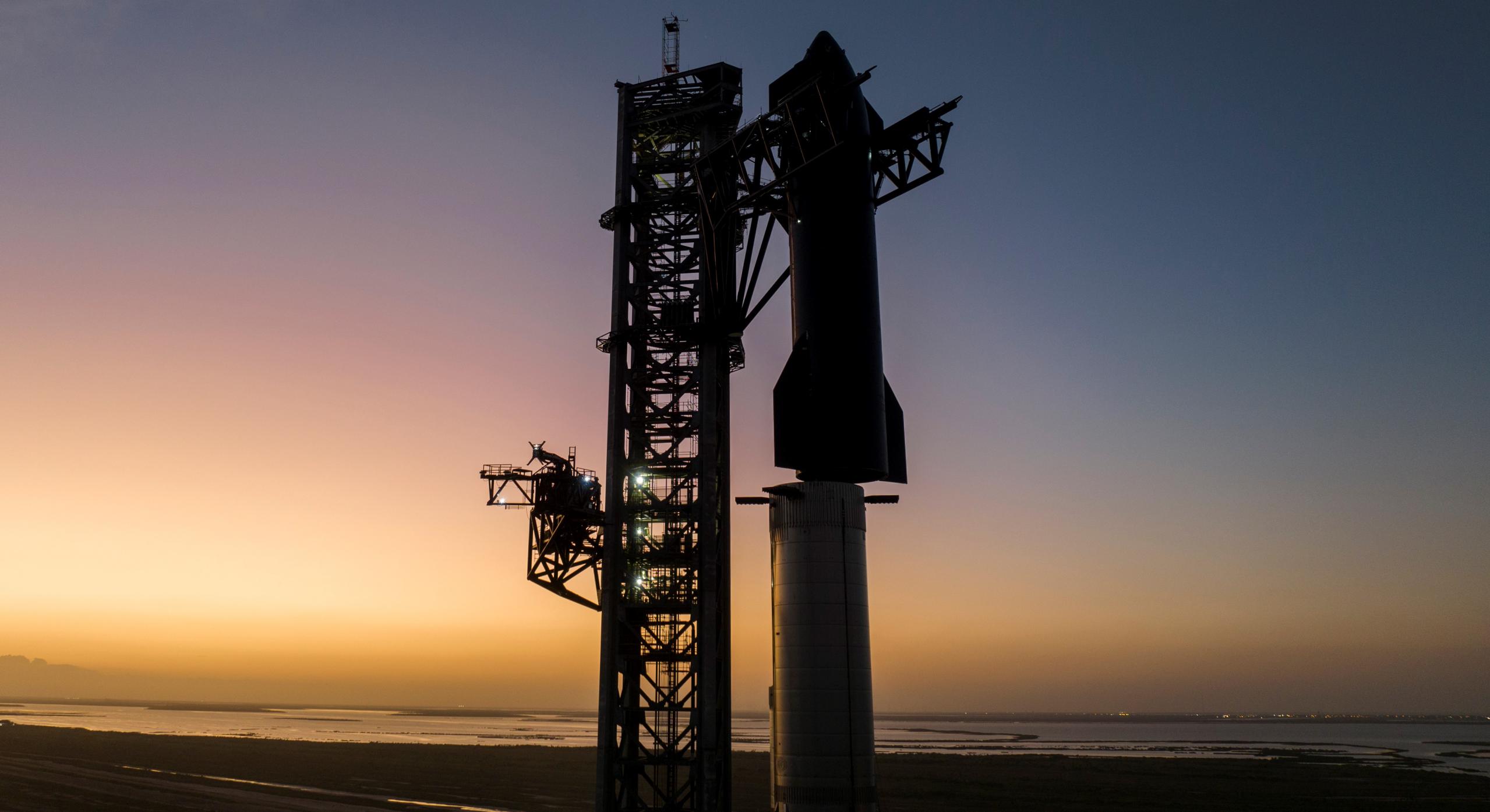

News
SpaceX fully stacks Starship rocket for the first time in six months
For the first time in more than six months, SpaceX has stacked both stages of its next-generation Starship rocket, creating the largest and most powerful launch vehicle ever fully assembled.
It’s not the first time. SpaceX has conducted three other ‘full-stack’ Starship demonstrations: once in August 2021 and again in February and March 2022. But earlier this year, SpaceX (or at least CEO Elon Musk) decided to give up on the Starship upper stage and Super Heavy booster prototypes that had supported all three of those prior tests and, at one point, been considered a candidate for the rocket’s first orbital launch attempt. Booster 4 and Ship 20 were consigned to a retirement yard by June 2022.
By then, SpaceX had already begun testing the new favorites for Starship’s orbital launch debut: Super Heavy Booster 7 (B7) and Starship 24 (S24). Almost exactly six months after the start of that busy period of testing, both prototypes recently reached the point where SpaceX was confident enough in their progress to combine the two for the most challenging phase of Starship testing yet.
After an aborted predawn attempt on October 11th, SpaceX technicians worked out some mystery kinks in crucial infrastructure located at Starship’s first (nearly) finished orbital launch pad in Boca Chica, Texas. As part of a cart-before-horse gamble made by CEO Elon Musk that has seen SpaceX entirely remove legs from all recent Starship and Super Heavy prototypes in the hope that it will one day be able to catch the building-sized rocket stages out of mid-air, the company has built a launch tower ~145 meters (~475 ft) tall and outfitted it with three giant robotic arms. Two of those arms are identical and linked together, forming a sort of claw that could one day close around hovering rockets to preclude the need for landing legs. A simpler third arm swings in and out to connect Starship’s upper stage to the launch pad’s power, propellant, and gas supplies.
The ‘chopsticks,’ as they’re known, have another even more important purpose: assembling Starship rockets at the launch pad. Thanks to their sturdy connection to a tower with a foundation sunk deep into the Boca Chica wetlands and a design that forgoes a hanging hook or jig for giant arms, they are far less sensitive to winds than the immense crane otherwise required to stack Starship on top of Super Heavy. Sitting a stone’s throw from the Gulf of Mexico, storms and high winds are not exactly uncommon.
Around sunset on October 11th, SpaceX had better luck on its third attempt and was able to move the arms into place under Ship 24. Weighing 100 tons or more (~220,000+ lb) and measuring nine meters (~30 ft) wide and ~50 meters (~165 ft) tall, the Starship was then slowly lifted about 80 meters (~250 ft) off the ground, translated over to Booster 7, and lowered on top of the 69-meter-tall (~225 ft) first stage. After about two more hours of robotically tweaking their positions, the two Starship stages were finally secured together. With the arms still attached to Ship 24, SpaceX workers were able to approach the rocket and prepare to connect the swing arm’s quick-disconnect umbilical to Starship.
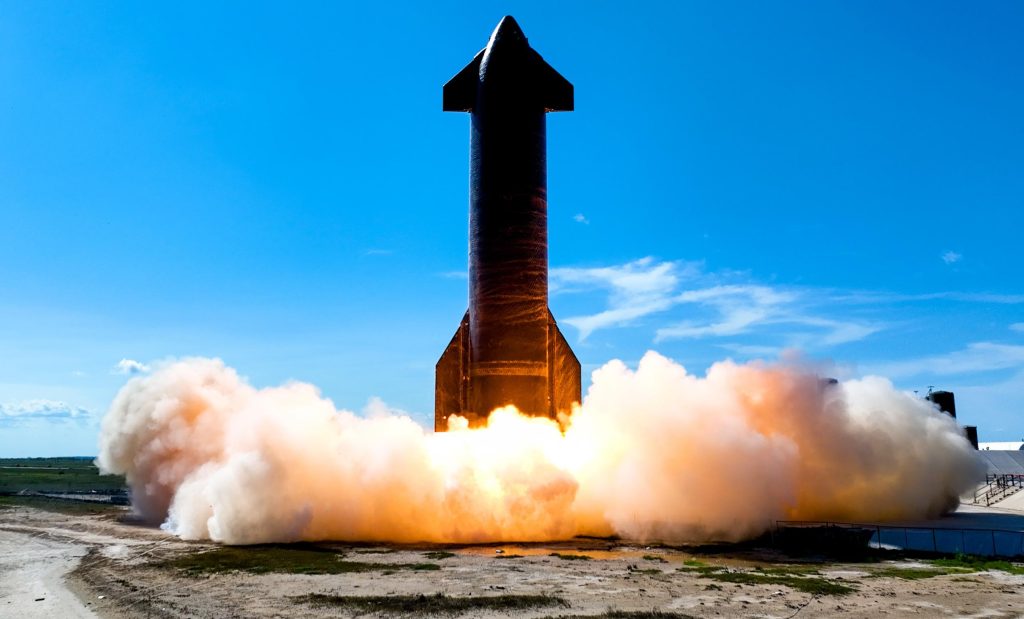
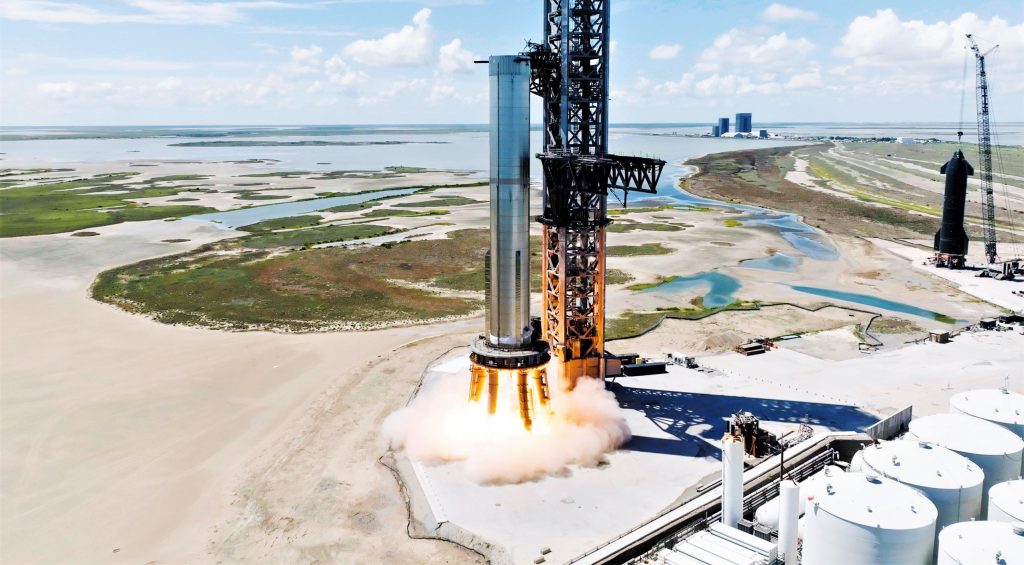
Since they began qualification testing in April and May 2022, Booster 7 and Ship 24 have each completed several cryogenic proof tests, eight ‘spin-primes’ of some or all of their Raptor engines, and several static fires of those same engines. Most recently, Ship 24 ignited all six of its Raptors, but the seemingly successful September 8th test was followed by more than a month of apparent repairs. Booster 7 last completed a static fire that ignited a record seven of its 33 Raptor engines – offering an idea of how much further SpaceX still has to go to finish testing the Super Heavy.
According to CEO Elon Musk, Booster 7 and Ship 24 will attempt Starship’s first full-stack wet dress rehearsal (WDR) once all is in order. The prototypes will be simultaneously loaded with around 5000 tons (~11M lb) of liquid oxygen and methane propellant and then run through a launch countdown. Diverging just before ignition and liftoff, a WDR is meant to be more or less identical to a launch attempt.
If the wet dress rehearsal goes to plan, SpaceX will then attempt to simultaneously ignite all 33 of the Raptor engines installed on Super Heavy B7, almost certainly making it the most powerful liquid rocket ever tested. Even if all 33 engines never reach more than 60% of their maximum thrust of 230 tons (~510,000 lbf), they will likely break the Soviet N-1 rocket’s record of 4500 tons of thrust (~10M lbf) at sea level. It would also be the most rocket engines ever simultaneously ignited on one vehicle. SpaceX will be pushing the envelope by several measures, and success is far from guaranteed.
It’s unclear if SpaceX will immediately attempt a full wet dress rehearsal or 33-engine static fire. Based on the history of Ship 24 and Booster 7 testing, it would be a departure from the norm if the company doesn’t slowly build up to both major milestones with smaller tests in the interim. At minimum, assuming WDR testing is completed without major issue, SpaceX will likely attempt at least one or more interim static fires with fewer than 33 engines before attempting the first full test.
If both milestones (a full WDR and 33-engine static fire) are completed without significant issue, there’s a chance that SpaceX could move directly into preparations for Starship’s first orbital launch attempt without unstacking the rocket. In the likelier scenario that some issues arise and some repairs are required, the path will be more circuitous but should still end in an orbital launch attempt late this year or early next.
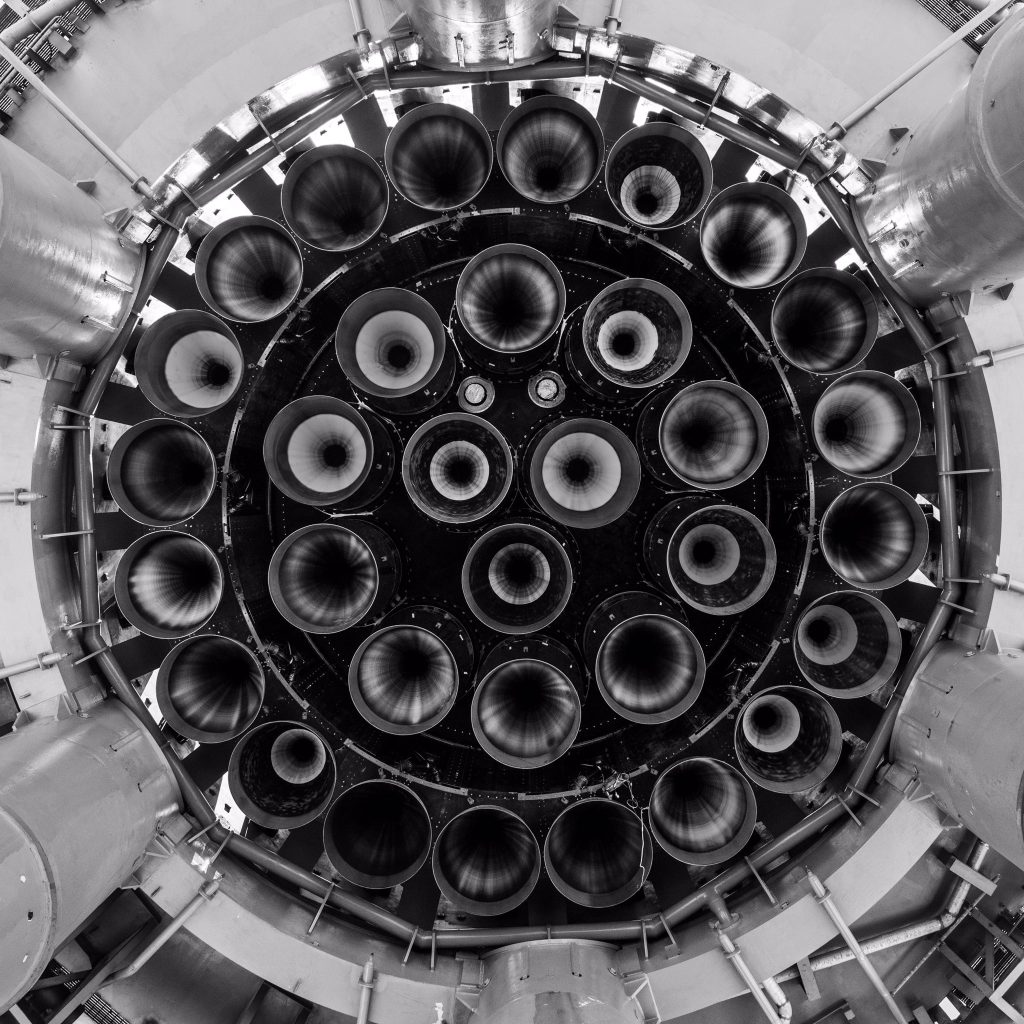
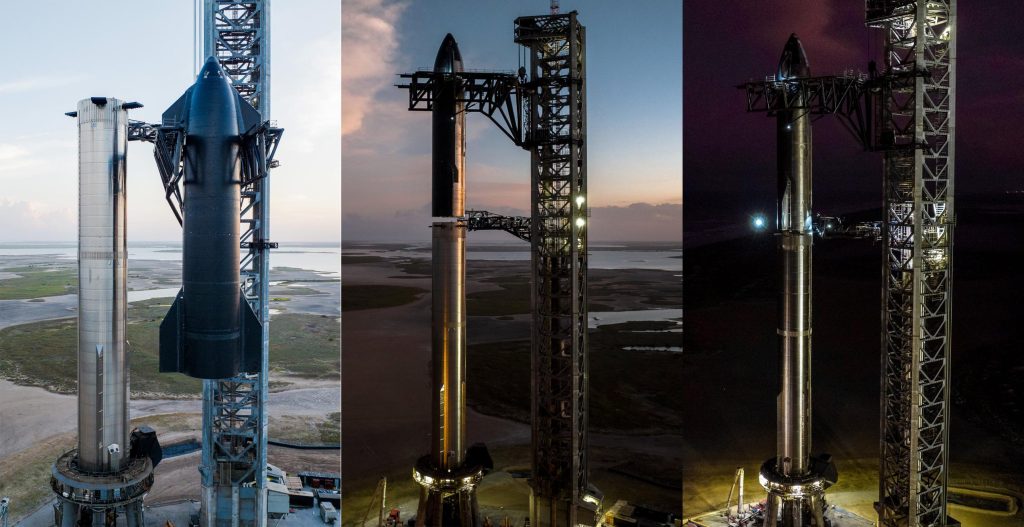
News
Tesla cleared in Canada EV rebate investigation
Tesla has been cleared in an investigation into the company’s staggering number of EV rebate claims in Canada in January.

Canadian officials have cleared Tesla following an investigation into a large number of claims submitted to the country’s electric vehicle (EV) rebates earlier this year.
Transport Canada has ruled that there was no evidence of fraud after Tesla submitted 8,653 EV rebate claims for the country’s Incentives for Zero-Emission Vehicles (iZEV) program, as detailed in a report on Friday from The Globe and Mail. Despite the huge number of claims, Canadian authorities have found that the figure represented vehicles that had been delivered prior to the submission deadline for the program.
According to Transport Minister Chrystia Freeland, the claims “were determined to legitimately represent cars sold before January 12,” which was the final day for OEMs to submit these claims before the government suspended the program.
Upon initial reporting of the Tesla claims submitted in January, it was estimated that they were valued at around $43 million. In March, Freeland and Transport Canada opened the investigation into Tesla, noting that they would be freezing the rebate payments until the claims were found to be valid.
READ MORE ON ELECTRIC VEHICLES: EVs getting cleaner more quickly than expected in Europe: study
Huw Williams, Canadian Automobile Dealers Association Public Affairs Director, accepted the results of the investigation, while also questioning how Tesla knew to submit the claims that weekend, just before the program ran out.
“I think there’s a larger question as to how Tesla knew to run those through on that weekend,” Williams said. “It doesn’t appear to me that we have an investigation into any communication between Transport Canada and Tesla, between officials who may have shared information inappropriately.”
Tesla sales have been down in Canada for the first half of this year, amidst turmoil between the country and the Trump administration’s tariffs. Although Elon Musk has since stepped back from his role with the administration, a number of companies and officials in Canada were calling for a boycott of Tesla’s vehicles earlier this year, due in part to his association with Trump.
News
Tesla Semis to get 18 new Megachargers at this PepsiCo plant
PepsiCo is set to add more Tesla Semi Megachargers, this time at a facility in North Carolina.

Tesla partner PepsiCo is set to build new Semi charging stations at one of its manufacturing sites, as revealed in new permitting plans shared this week.
On Friday, Tesla charging station scout MarcoRP shared plans on X for 18 Semi Megacharging stalls at PepsiCo’s facility in Charlotte, North Carolina, coming as the latest update plans for the company’s increasingly electrified fleet. The stalls are set to be built side by side, along with three Tesla Megapack grid-scale battery systems.
The plans also note the faster charging speeds for the chargers, which can charge the Class 8 Semi at speeds of up to 1MW. Tesla says that the speed can charge the Semi back to roughly 70 percent in around 30 minutes.
You can see the site plans for the PepsiCo North Carolina Megacharger below.

Credit: PepsiCo (via MarcoRPi1 on X)

Credit: PepsiCo (via MarcoRPi1 on X)
READ MORE ON THE TESLA SEMI: Tesla to build Semi Megacharger station in Southern California
PepsiCo’s Tesla Semi fleet, other Megachargers, and initial tests and deliveries
PepsiCo was the first external customer to take delivery of Tesla’s Semis back in 2023, starting with just an initial order of 15. Since then, the company has continued to expand the fleet, recently taking delivery of an additional 50 units in California. The PepsiCo fleet was up to around 86 units as of last year, according to statements from Semi Senior Manager Dan Priestley.
Additionally, the company has similar Megachargers at its facilities in Modesto, Sacramento, and Fresno, California, and Tesla also submitted plans for approval to build 12 new Megacharging stalls in Los Angeles County.
Over the past couple of years, Tesla has also been delivering the electric Class 8 units to a number of other companies for pilot programs, and Priestley shared some results from PepsiCo’s initial Semi tests last year. Notably, the executive spoke with a handful of PepsiCo workers who said they really liked the Semi and wouldn’t plan on going back to diesel trucks.
The company is also nearing completion of a higher-volume Semi plant at its Gigafactory in Nevada, which is expected to eventually have an annual production capacity of 50,000 Semi units.
Tesla executive teases plan to further electrify supply chain
News
Tesla sales soar in Norway with new Model Y leading the charge
Tesla recorded a 54% year-over-year jump in new vehicle registrations in June.

Tesla is seeing strong momentum in Norway, with sales of the new Model Y helping the company maintain dominance in one of the world’s most electric vehicle-friendly markets.
Model Y upgrades and consumer preferences
According to the Norwegian Road Federation (OFV), Tesla recorded a 54% year-over-year jump in new vehicle registrations in June. The Model Y led the charge, posting a 115% increase compared to the same period last year. Tesla Norway’s growth was even more notable in May, with sales surging a whopping 213%, as noted in a CNBC report.
Christina Bu, secretary general of the Norwegian EV Association (NEVA), stated that Tesla’s strong market performance was partly due to the updated Model Y, which is really just a good car, period.
“I think it just has to do with the fact that they deliver a car which has quite a lot of value for money and is what Norwegians need. What Norwegians need, a large luggage space, all wheel drive, and a tow hitch, high ground clearance as well. In addition, quite good digital solutions which people have gotten used to, and also a charging network,” she said.
Tesla in Europe
Tesla’s success in Norway is supported by long-standing government incentives for EV adoption, including exemptions from VAT, road toll discounts, and access to bus lanes. Public and home charging infrastructure is also widely available, making the EV ownership experience in the country very convenient.
Tesla’s performance in Europe is still a mixed bag, with markets like Germany and France still seeing declines in recent months. In areas such as Norway, Spain, and Portugal, however, Tesla’s new car registrations are rising. Spain’s sales rose 61% and Portugal’s sales rose 7% last month. This suggests that regional demand may be stabilizing or rebounding in pockets of Europe.
-

 Elon Musk2 weeks ago
Elon Musk2 weeks agoTesla investors will be shocked by Jim Cramer’s latest assessment
-

 Elon Musk2 days ago
Elon Musk2 days agoxAI launches Grok 4 with new $300/month SuperGrok Heavy subscription
-

 Elon Musk4 days ago
Elon Musk4 days agoElon Musk confirms Grok 4 launch on July 9 with livestream event
-

 News1 week ago
News1 week agoTesla Model 3 ranks as the safest new car in Europe for 2025, per Euro NCAP tests
-

 Elon Musk2 weeks ago
Elon Musk2 weeks agoA Tesla just delivered itself to a customer autonomously, Elon Musk confirms
-

 Elon Musk1 week ago
Elon Musk1 week agoxAI’s Memphis data center receives air permit despite community criticism
-

 News2 weeks ago
News2 weeks agoXiaomi CEO congratulates Tesla on first FSD delivery: “We have to continue learning!”
-

 News2 weeks ago
News2 weeks agoTesla sees explosive sales growth in UK, Spain, and Netherlands in June

















